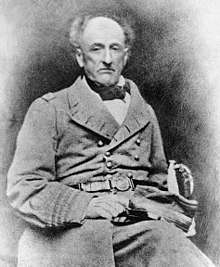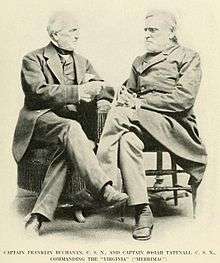Franklin Buchanan
Franklin Buchanan (September 17, 1800 – May 11, 1874) was an officer in the United States Navy who became the only full admiral in the Confederate Navy during the American Civil War. He also commanded the ironclad CSS Virginia.
Franklin Buchanan | |
|---|---|
 Photographed in Confederate Navy uniform during the Civil War. | |
| Born | 17 September 1800 Baltimore, Maryland |
| Died | 11 May 1874 (aged 73) Talbot County, Maryland |
| Burial | Wye House family plot outside Easton, Maryland |
| Allegiance | |
| Service/ | |
| Years of service | USN 1815–1861 CSN 1861–1865 |
| Rank | |
| Commands held | USS Vincennes USS Germantown USS Susquehanna James River Squadron CSS Virginia CSS Tennessee |
| Battles/wars | Mexican–American War American Civil War |
| Other work | College president and businessman |
Early life
Franklin Buchanan was born in Baltimore, Maryland on September 13, 1800. He was the fifth child and third son of a physician, George Buchanan and Laetitia McKean Buchanan.[1] The Buchanan side of his family arrived in the United States from Scotland. His paternal grandfather was a general with the Maryland Militia during the Revolutionary War while his maternal grandfather Thomas McKean was one of the signers of the Declaration of Independence.

He joined the U.S. Navy on January 28, 1815 and became a midshipman; he was promoted to lieutenant on January 13, 1825, commander on September 8, 1841 and then captain on September 14, 1855.[1]
On February 19, 1835, at Annapolis, Maryland, he married Ann Catherine Lloyd. They had nine children: eight daughters and a son.
U.S. Navy
During the 45 years he served in the U.S. Navy, Buchanan had extensive and worldwide sea duty. He commanded the sloops of war Vincennes and Germantown during the 1840s and the steam frigate Susquehanna in the Perry Expedition to Japan from 1852–1854.[1] In 1845, at the request of the U.S. Secretary of the Navy, he submitted plans to his superiors proposing a naval school which would lead to the creation of the United States Naval Academy that very year; for his efforts, he was appointed the first Superintendent of the Naval School—its first name—where he served in 1845–1847. This assignment was followed by notable Mexican–American War service in 1847–1848. From 1859–1861, Buchanan was the Commandant of the Washington Navy Yard.
With the Civil War upon him, he resigned his commission on April 22, 1861, expecting his home State of Maryland to eventually secede. When that didn't happen, he tried to recall his resignation, but U.S. Secretary of the Navy, Gideon Welles said he did not want traitors or half-hearted patriots in his navy and refused to reinstate him.[1] Thus in May, 1861 he was out of the U.S. Navy.
Civil War
.jpg)
On September 5, 1861, Franklin Buchanan joined the Confederate Navy and was given a captain's commission. On February 24, 1862, the Confederate States Secretary of the Navy, Stephen Mallory appointed Buchanan to the office of Confederate Navy James River Squadron Flag Officer and he then selected the newly built ironclad CSS Virginia to be his flagship.
Buchanan was the captain of CSS Virginia (formerly USS Merrimack) during the Battle of Hampton Roads in Virginia.[2] He climbed to the top deck of Virginia and began furiously firing toward shore with a carbine as USS Congress was shelled.[3] He soon was brought down by a sharpshooter's minie ball to the thigh. He would eventually recover from his leg wound. He did not get to command Virginia against USS Monitor. That honor went to Catesby ap Roger Jones. But Buchanan had handed the United States Navy the worst defeat it would take until the Attack on Pearl Harbor.[4]

In August 1862, Buchanan was promoted to the rank of Full Admiral – the only officer so honored in the Confederate Navy – and was sent to take command of Confederate naval forces stationed at Mobile Bay, Alabama.[5] He oversaw the construction of the ironclad CSS Tennessee of which the keel was laid in October 1862. He on board Tennessee during the Battle of Mobile Bay with Rear Admiral David Glasgow Farragut's Union fleet on August 5, 1864.[6] Wounded and taken prisoner, Buchanan was not exchanged until February 1865.[6] He was on convalescent leave until the Civil War ended a few months later.
Later life
Following the conflict, Buchanan lived in Maryland and in Mobile, Alabama until 1870, when he again took up residence in Maryland. He died there on May 11, 1874. He is buried at the Wye House family plot outside Easton, Maryland.
Legacy
Three U.S. Navy destroyers have been named Buchanan in honor of Admiral Franklin Buchanan: DD-131 (Wickes class), DD-484 (Gleaves class), and DDG-14 (Charles F. Adams class). The Superintendent's quarters at the United States Naval Academy is also named the Buchanan House.
See also
- List of Superintendents of the United States Naval Academy
References
- Quarstein, "Franklin Buchanan"
- Symonds, p. 152.
- Jones, Terry L., Historical dictionary of the Civil War, Lanham, Scarecrow Press, 2011, p . 638.
- United States Naval Institute Proceedings, Volume 88, U.S. Naval Institute, 1962, p. 68.
- Tucker, Spencer, Almanac of American military history, Santa Barbara, ABC-CLIO, 2013, p. 668.
- Symonds, p. 254.
Bibliography
- Quarstein, John V., The CSS Virginia: Sink before surrender, Charleston, History Press, 2012, ISBN 9781609495800.
- Symonds, Craig L., Confederate Admiral: The Life and Wars of Franklin Buchanan, Naval Institute Press, 1999, ISBN 978-1-59114-846-3.
External links
| Wikimedia Commons has media related to Franklin Buchanan. |
- Photos of Buchanan – from the Naval Historical Center, Washington, D.C.
- Franklin Buchanan Naval Papers, 1796–1847 (bulk 1817–1847) MS 1 held by Special Collections & Archives, Nimitz Library at the United States Naval Academy
| Military offices | ||
|---|---|---|
| Preceded by None |
Superintendent of United States Naval Academy 1845–1847 |
Succeeded by George P. Upshur |
| Preceded by French Forrest |
Commander of the James River Squadron February 27, 1862 – March 29, 1862 |
Succeeded by Josiah Tattnall |
| Academic offices | ||
| Preceded by Charles Minor |
President of the Maryland Agricultural College 1868–1869 |
Succeeded by Samuel Register |